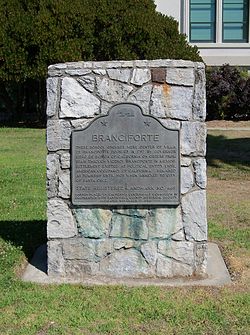
The Spanish missions in California formed a series of 21 religious outposts or missions established between 1769 and 1833 in what is now the U.S. state of California. The missions were established by Catholic priests of the Franciscan order to evangelize indigenous peoples backed by the military force of the Spanish Empire. The missions were part of the expansion and settlement of New Spain through the formation of Alta California, expanding the empire into the most northern and western parts of Spanish North America. Civilian settlers and soldiers accompanied missionaries and formed settlements like the Pueblo de Los Ángeles.

Mission San Juan Capistrano is a Spanish mission in San Juan Capistrano, Orange County, California. Founded November 1, 1776 in colonial Las Californias by Spanish Catholic missionaries of the Franciscan Order, it was named for Saint John of Capistrano. The Spanish Colonial Baroque style church was located in the Alta California province of the Viceroyalty of New Spain. The Mission was founded less than 60 yards from the village of Acjacheme. The Mission was secularized by the Mexican government in 1833, and returned to the Roman Catholic Church by the United States government in 1865. The Mission was damaged over the years by a number of natural disasters, but restoration and renovation efforts date from around 1910. It functions today as a museum.

Mission Santa Barbara is a Spanish mission in Santa Barbara, California, United States. Often referred to as the 'Queen of the Missions', it was founded by Padre Fermín Lasuén for the Franciscan order on December 4, 1786, the feast day of Saint Barbara, as the tenth mission of what would later become 21 missions in Alta California.
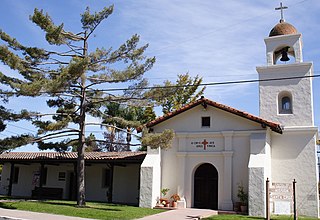
Mission Santa Cruz is a replica Spanish Californian mission in Santa Cruz, California. Located at the foot of a what would later be named Mission Hill, the original mission was founded on August 28, 1791, by Father Fermín Francisco de Lasuén, the successor of Father Junipero Serra. The mission was dedicated that same year, and in the winter, the waters of the San Lorenzo River flooded its banks, and caused extensive damage to the original building, and so the mission was relocated to the top of Mission Hill. After earthquake damage and years of neglect, this second mission fell into disrepair, and much of it, though not all, was removed to accommodate the construction of the Holy Cross Church. The Holy Cross Church paid for the construction of the replica in the 1930s, and today it functions as a historical monument and chapel for the parish.

Mission San Fernando Rey de España is a Spanish mission in the Mission Hills community of Los Angeles, California. The mission was founded on 8 September 1797 at the site of Achooykomenga, and was the seventeenth of the twenty-one Spanish missions established in Alta California. Named for Saint Ferdinand, the mission is the namesake of the nearby city of San Fernando and the San Fernando Valley.

Mission San Francisco Solano was the 21st, last, and northernmost mission in Alta California. It was named for Saint Francis Solanus. It was the only mission built in Alta California after Mexico gained independence from Spain. The difficulty of its beginning demonstrates the confusion resulting from that change in governance. The California Governor wanted a robust Mexican presence north of the San Francisco Bay to keep the Russians who had established Fort Ross on the Pacific coast from moving further inland. A young Franciscan friar from Mission San Francisco de Asis wanted to move to a location with a better climate and access to a larger number of potential converts.

Santa Cruz is the largest city and the county seat of Santa Cruz County, in Northern California. As of the 2020 census, the city population was 62,956. Situated on the northern edge of Monterey Bay, Santa Cruz is a popular tourist destination, owing to its beaches, surf culture, and historic landmarks.

The Santa Margarita de Cortona Asistencia was established in 1787 as an asistencia ("sub-mission") to Mission San Luis Obispo de Tolosa, then in the Spanish Las Californias Province. Its site is near the present-day city of Santa Margarita, in San Luis Obispo County, central California.
Gabriel Moraga was a Sonoran-born Californio explorer and army officer. He was the son of the expeditionary José Joaquín Moraga who helped to lead the de Anza Expedition to California in 1774. Like his father, Moraga is one of the most notable Spanish expeditionaries in the history of Alta California and the origin of the names of many of the most notable rivers and cities of Northern California and the Central Valley.

El Presidio Real de Santa Bárbara, also known as the Royal Presidio of Santa Barbara, is a former military installation in Santa Barbara, California, United States. The presidio was built by Spain in 1782, with the mission of defending the Second Military District in California. In modern times, the Presidio serves as a significant tourist attraction, museum and an active archaeological site as part of El Presidio de Santa Barbara State Historic Park.
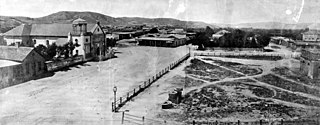
El Pueblo de Nuestra Señora la Reina de los Ángeles del Río de Porciúncula, shortened to Pueblo de los Ángeles, was the Spanish civilian pueblo settled in 1781, which became the American metropolis of Los Angeles. The pueblo was built using labor from the adjacent village of Yaanga and was totally dependent on local Indigenous labor for its survival.

The Diego Sepúlveda Adobe, sometimes called the Costa Mesa Estancia or the Santa Ana Estancia, is an adobe structure in Costa Mesa, Orange County, California. It is the second-oldest building still standing in the county.
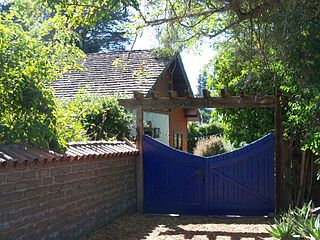
The Branciforte Adobe, also known as the Craig-Lorenzana Adobe, is the only remaining dwelling from the Villa de Branciforte, the settlement that was established in 1797 at the time of the Mission Santa Cruz.
José Joaquín de la Santísima Trinidad Moraga, usually simply known as José Joaquín Moraga, was a Spanish colonial expeditionary and soldier who founded San Jose, California, in 1777.
The history of Santa Barbara, California, begins approximately 13,000 years ago with the arrival of the first Native Americans. The Spanish came in the 18th century to occupy and Christianize the area, which became part of Mexico following the Mexican War of Independence. In 1848, the expanding United States acquired the town along with the rest of California as a result of defeating Mexico in the Mexican–American War. Santa Barbara transformed then from a small cluster of adobes into successively a rowdy, lawless Gold Rush era town; a Victorian-era health resort; a center of silent film production; an oil boom town; a town supporting a military base and hospital during World War II; and finally it became the economically diverse resort destination it remains in the present day. Twice destroyed by earthquakes, in 1812 and 1925, it was rebuilt after the second one in a Spanish Colonial style.

The Mission Revival style was part of an architectural movement, beginning in the late 19th century, for the revival and reinterpretation of American colonial styles. Mission Revival drew inspiration from the late 18th and early 19th century Spanish missions in California. It is sometimes termed California Mission Revival, particularly when used elsewhere, such as in New Mexico and Texas which have their own unique regional architectural styles. In Australia, the style is known as Spanish Mission.

The Mexican Secularization Act of 1833, officially called the Decree for the Secularization of the Missions of California, was an act passed by the Congress of the Union of the First Mexican Republic which secularized the Californian missions. The act nationalized the missions, transferring their ownership from the Franciscan Order of the Catholic Church to the Mexican authorities.
Branciforte may refer to:
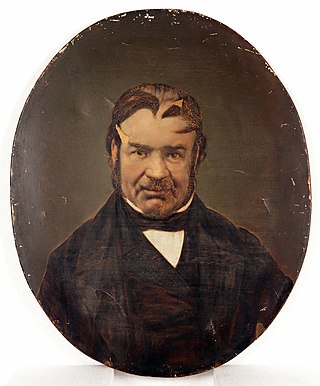
Don Antonio María Suñol was a Spanish-born Californio businessman, ranchero, and politician. Suñol served two terms as Alcalde of San José (mayor) and was one of the largest landowners in the Bay Area. He is the namesake of the town of Sunol and the founder of Willow Glen, an affluent neighborhood of San Jose.
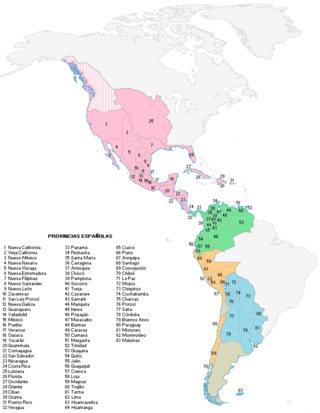
Spanish colonial authorities in North America established misiones, presidios and villas or pueblos. Official pueblo establishments were granted four square Spanish leagues of land and were required to be sited at least five Spanish leagues away from any other pueblo. According to one Arizona history, "Each organized pueblo was to have at least thirty inhabitants, each one to have ten breeding cows, four oxen, one brood mare, one sow, twenty Castillian ewes, six hens and one cock. House lots and sowing lands were to be distributed among pueblo settlers." Among the leadership of a pueblo was an alcalde.
